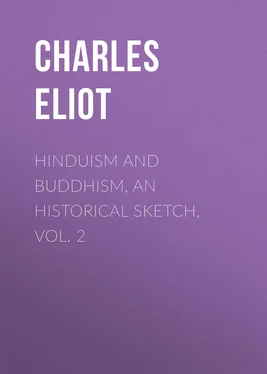Charles Eliot - Hinduism and Buddhism, An Historical Sketch, Vol. 2
Здесь есть возможность читать онлайн «Charles Eliot - Hinduism and Buddhism, An Historical Sketch, Vol. 2» — ознакомительный отрывок электронной книги совершенно бесплатно, а после прочтения отрывка купить полную версию. В некоторых случаях можно слушать аудио, скачать через торрент в формате fb2 и присутствует краткое содержание. Жанр: foreign_religion, Философия, Религиозная литература, foreign_psychology, foreign_antique, foreign_prose, на английском языке. Описание произведения, (предисловие) а так же отзывы посетителей доступны на портале библиотеки ЛибКат.
- Название:Hinduism and Buddhism, An Historical Sketch, Vol. 2
- Автор:
- Жанр:
- Год:неизвестен
- ISBN:нет данных
- Рейтинг книги:4 / 5. Голосов: 1
-
Избранное:Добавить в избранное
- Отзывы:
-
Ваша оценка:
- 80
- 1
- 2
- 3
- 4
- 5
Hinduism and Buddhism, An Historical Sketch, Vol. 2: краткое содержание, описание и аннотация
Предлагаем к чтению аннотацию, описание, краткое содержание или предисловие (зависит от того, что написал сам автор книги «Hinduism and Buddhism, An Historical Sketch, Vol. 2»). Если вы не нашли необходимую информацию о книге — напишите в комментариях, мы постараемся отыскать её.
Hinduism and Buddhism, An Historical Sketch, Vol. 2 — читать онлайн ознакомительный отрывок
Ниже представлен текст книги, разбитый по страницам. Система сохранения места последней прочитанной страницы, позволяет с удобством читать онлайн бесплатно книгу «Hinduism and Buddhism, An Historical Sketch, Vol. 2», без необходимости каждый раз заново искать на чём Вы остановились. Поставьте закладку, и сможете в любой момент перейти на страницу, на которой закончили чтение.
Интервал:
Закладка:
1. A belief in Bodhisattvas and in the power of human beings to become Bodhisattvas.
2. A code of altruistic ethics which teaches that everyone must do good in the interest of the whole world and make over to others any merit he may acquire by his virtues. The aim of the religious life is to become a Bodhisattva, not to become an Arhat.
3. A doctrine that Buddhas are supernatural beings, distributed through infinite space and time, and innumerable. In the language of later theology a Buddha has three bodies and still later there is a group of five Buddhas.
4. Various systems of idealist metaphysics, which tend to regard the Buddha essence or Nirvana much as Brahman is regarded in the Vedanta.
5. A canon composed in Sanskrit and apparently later than the Pali Canon.
6. Habitual worship of images and elaboration of ritual. There is a dangerous tendency to rely on formulæ and charms.
7. A special doctrine of salvation by faith in a Buddha, usually Amitâbha, and invocation of his name. Mahayanism can exist without this doctrine but it is tolerated by most sects and considered essential by some.
CHAPTER XVII
BODHISATTVAS
Let us now consider these doctrines and take first the worship of Bodhisattvas. This word means one whose essence is knowledge but is used in the technical sense of a being who is in process of obtaining but has not yet obtained Buddhahood. The Pali Canon shows little interest in the personality of Bodhisattvas and regards them simply as the preliminary or larval form of a Buddha, either Śâkyamuni 5 5 In dealing with the Mahayanists, I use the expression Śâkyamuni in preference to Gotama. It is their own title for the teacher and it seems incongruous to use the purely human name of Gotama in describing doctrines which represent him as superhuman.
or some of his predecessors. It was incredible that a being so superior to ordinary humanity as a Buddha should be suddenly produced in a human family nor could he be regarded as an incarnation in the strict sense. But it was both logical and edifying to suppose that he was the product of a long evolution of virtue, of good deeds and noble resolutions extending through countless ages and culminating in a being superior to the Devas. Such a being awaited in the Tushita heaven the time fixed for his appearance on earth as a Buddha and his birth was accompanied by marvels. But though the Pali Canon thus recognizes the Bodhisattva as a type which, if rare, yet makes its appearance at certain intervals, it leaves the matter there. It is not suggested that saints should try to become Bodhisattvas and Buddhas, or that Bodhisattvas can be helpers of mankind. 6 6 But Kings Hsin-byu-shin of Burma and Śrî Sûryavaṃsa Râma of Siam have left inscriptions recording their desire to become Buddhas. See my chapters on Burma and Siam below. Mahayanist ideas may easily have entered these countries from China, but even in Ceylon the idea of becoming a Buddha or Bodhisattva is not unknown. See Manual of a Mystic (P.T.S. 1916), pp. xviii and 140.
But both these trains of thought are natural developments of the older ideas and soon made themselves prominent. It is a characteristic doctrine of Mahayanism that men can try and should try to become Bodhisattvas.
In the Pali Canon we hear of Arhats, Pacceka Buddhas, and perfect Buddhas. For all three the ultimate goal is the same, namely Nirvana, but a Pacceka Buddha is greater than an Arhat, because he has greater intellectual powers though he is not omniscient, and a perfect Buddha is greater still, partly because he is omniscient and partly because he saves others. But if we admit that the career of the Buddha is better and nobler, and also that it is, as the Introduction to the Jâtaka recounts, simply the result of an earnest resolution to school himself and help others, kept firmly through the long chain of existences, there is nothing illogical or presumptuous in making our goal not the quest of personal salvation, but the attainment of Bodhisattvaship, that is the state of those who may aspire to become Buddhas. In fact the Arhat, engrossed in his own salvation, is excused only by his humility and is open to the charge of selfish desire, since the passion for Nirvana is an ambition like any other and the quest for salvation can be best followed by devoting oneself entirely to others. But though my object here is to render intelligible the Mahayanist point of view including its objections to Hinayanism, I must defend the latter from the accusation of selfishness. The vigorous and authoritative character of Gotama led him to regard all mankind as patients requiring treatment and to emphasize the truth that they could cure themselves if they would try. But the Buddhism of the Pali Canon does not ignore the duties of loving and instructing others; 7 7 E.g. in Itivuttakam 75, there is a description of the man who is like a drought and gives nothing, the man who is like rain in a certain district and the man who is Sabbabhûtânukampako, compassionate to all creatures, and like rain falling everywhere. Similarly Ib. 84, and elsewhere, we have descriptions of persons (ordinary disciples as well as Buddhas) who are born for the welfare of gods and men bahujanahitâya, bahujanasukhâya, lokânukampâya, atthâya, hitâya, sukhâya devamanussânam.
it merely insists on man's power to save himself if properly instructed and bids him do it at once: "sell all that thou hast and follow me." And the Mahayana, if less self-centred, has also less self-reliance, and self-discipline. It is more human and charitable, but also more easygoing: it teaches the believer to lean on external supports which if well chosen may be a help, but if trusted without discrimination become paralyzing abuses. And if we look at the abuses of both systems the fossilized monk of the Hinayana will compare favourably with the tantric adept. It was to the corruptions of the Mahayana rather than of the Hinayana that the decay of Buddhism in India was due.
The career of the Bodhisattva was early divided into stages (bhûmi) each marked by the acquisition of some virtue in his triumphant course. The stages are variously reckoned as five, seven and ten. The Mahâvastu, 8 8 Ed. Senart, vol. I. p. 142.
which is the earliest work where the progress is described, enumerates ten without distinguishing them very clearly. Later writers commonly look at the Bodhisattva's task from the humbler point of view of the beginner who wishes to learn the initiatory stages. For them the Bodhisattva is primarily not a supernatural being or even a saint but simply a religious person who wishes to perform the duties and enjoy the privileges of the Church to the full, much like a communicant in the language of contemporary Christianity. We have a manual for those who would follow this path, in the Bodhicaryâvatâra of Śântideva, which in its humility, sweetness and fervent piety has been rightly compared with the De Imitatione Christi. In many respects the virtues of the Bodhisattva are those of the Arhat. His will must be strenuous and concentrated; he must cultivate the strictest morality, patience, energy, meditation and knowledge. But he is also a devotee, a bhakta : he adores all the Buddhas of the past, present and future as well as sundry superhuman Bodhisattvas, and he confesses his sins, not after the fashion of the Pâtimokkha, but by accusing himself before these heavenly Protectors and vowing to sin no more.
Śântideva lived in the seventh century 9 9 The Bodhicaryâvatâra was edited by Minayeff, 1889 and also in the Journal of the Buddhist Text Society and the Bibliotheca Indica . De la Vallée Poussin published parts of the text and commentary in his Bouddhisme and also a translation in 1907.
but tells us that he follows the scriptures and has nothing new to say. This seems to be true for, though his book being a manual of devotion presents its subject-matter in a dogmatic form, its main ideas are stated and even elaborated in the Lotus. Not only are eminent figures in the Church, such as Sâriputra and Ânanda, there designated as future Buddhas, but the same dignity is predicted wholesale for five hundred and again for two thousand monks while in Chapter x is sketched the course to be followed by "young men or young ladies of good family" who wish to become Bodhisattvas. 10 10 The career of the Bodhisattva is also discussed in detail in the Avatamsaka sûtra and in works attributed to Nâgârjuna and Sthiramati, the Lakshaṇa-vimukta-hṛidaya-śâstra and the Mahâyâna-dharma-dhâtvaviśeshata-śâstra. I only know of these works as quoted by Teitaro Suzuki.
The chief difference is that the Bodhicaryâvatâra portrays a more spiritual life, it speaks more of devotion, less of the million shapes that compose the heavenly host: more of love and wisdom, less of the merits of reading particular sûtras. While rendering to it and the faith that produced it all honour, we must remember that it is typical of the Mahayana only in the sense that the De Imitatione Christi is typical of Roman Catholicism, for both faiths have other sides.
Интервал:
Закладка:
Похожие книги на «Hinduism and Buddhism, An Historical Sketch, Vol. 2»
Представляем Вашему вниманию похожие книги на «Hinduism and Buddhism, An Historical Sketch, Vol. 2» списком для выбора. Мы отобрали схожую по названию и смыслу литературу в надежде предоставить читателям больше вариантов отыскать новые, интересные, ещё непрочитанные произведения.
Обсуждение, отзывы о книге «Hinduism and Buddhism, An Historical Sketch, Vol. 2» и просто собственные мнения читателей. Оставьте ваши комментарии, напишите, что Вы думаете о произведении, его смысле или главных героях. Укажите что конкретно понравилось, а что нет, и почему Вы так считаете.












